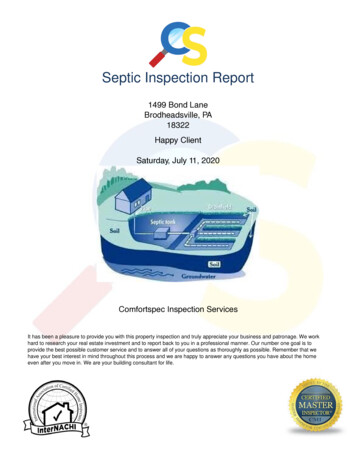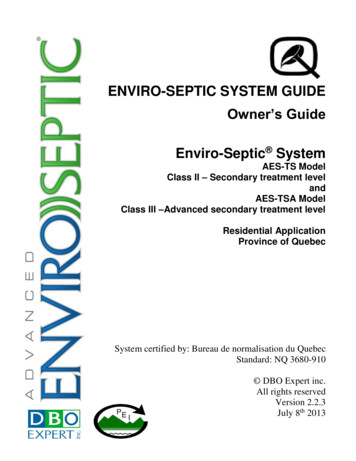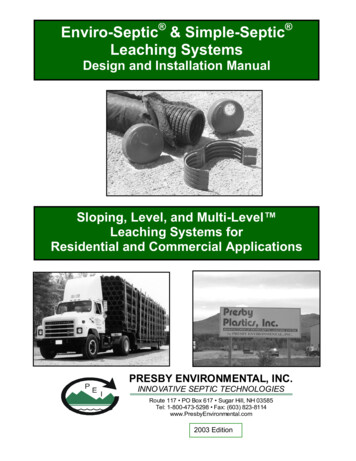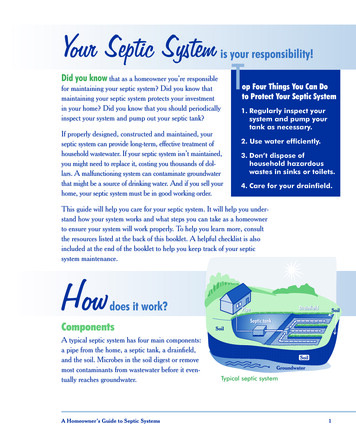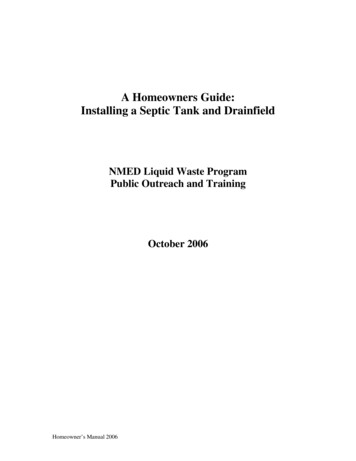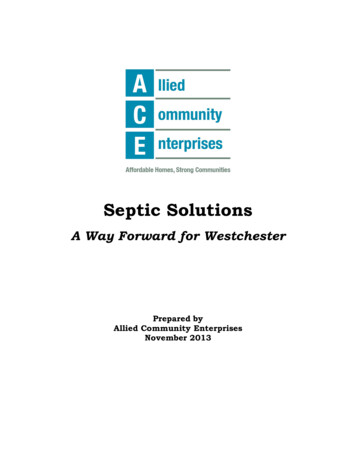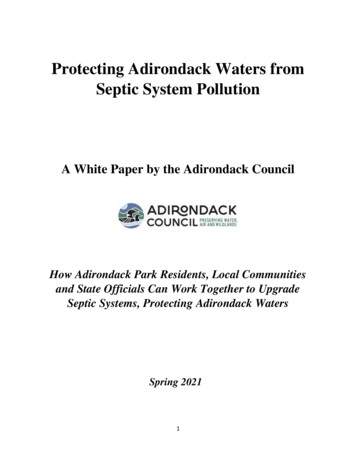
Transcription
Protecting Adirondack Waters fromSeptic System PollutionA White Paper by the Adirondack CouncilHow Adirondack Park Residents, Local Communitiesand State Officials Can Work Together to UpgradeSeptic Systems, Protecting Adirondack WatersSpring 20211
Table of ContentsIntroduction. 3-4Homeowners’ Resources for their Septic Systems. 5-8Model Local Ordinances and Inspection Practices in AdirondackCommunities including Transfer Laws/Inspection Requirements. 8-11Septic System Technologies: Existing Systems & New Innovations. 11-12New York State Adirondacks Water Quality Monitoringand Septic System Program Needs: Concepts for the Future. 12-15Conclusion: An Agenda Moving Forward. 15-16Appendix A: Septic System Technologies: Existing Systems Commonly Usedas well as Innovations and New Approaches. 17-26Written and Researched by:David J. Miller, Adirondack Council Clean Water Program CoordinatorSpring 2021Copyright 2021 Adirondack Council. All Rights Reserved.Adirondack Council Main Office103 Hand Ave - Suite 3PO Box D-2Elizabethtown, NY 12932518-873-2240info@adirondackcouncil.org2
Protecting Adirondack Waters from SepticSystem PollutionIntroductionThis report documents what Adirondack communities, residents, and state officials aredoing to protect the Park’s precious, clean waters as well as provide paths forward to mitigateand reduce pollution sources in the Park. It identifies opportunities to scale up successfully testedprograms to resolve the unaddressed situation of septic system pollution where untreated or onlypartially treated sewage still negatively impacts the state’s iconic Adirondack lakes, rivers, andpure drinking water resources.Since the 19th Century, for more than 135 years, the State of New York in partnershipwith owners of private lands in the Adirondacks, have invested in protecting the clean water andwildlands of the State. Since 2015, the State of New York awarded 152 million in clean waterand drinking water funds for wastewater treatment plants and sewer systems infrastructureprojects to treat human waste streams for twenty-five larger communities in the Adirondacks.However, the majority of the one hundred plus Adirondack communities are smaller andrely on individual septic systems to treat homeowner’s and small business wastewater. Severalcommunities have piloted programs to address failing septic systems. Scaling those localprograms up to reach across the Park would benefit millions of people and protect public health.The clean water in the 6 million-acre Adirondack Park’s 2,800 lakes and ponds, morethan 1,500 miles of rivers and an estimated 30,000 miles of brooks and streams is the lifebloodfor the people, wildlife, and communities of the Park. The purity of this water is threatened bypollution including untreated or partially treated sewage flowing from failing septic systems.Efforts are underway to make sure cross-state air pollution does not increase and bringback acid rain, poisoning Adirondack Lakes. Efforts are under way to address the overapplication of road salt, contaminating lakes and drinking water. Efforts are continuing tostrengthen protections to address the threats of climate change and aquatic invasive species. Thisreport documents success efforts to address failing septic systems, that if scaled up could addressthis threat park-wide, benefiting both residents and visitors, the natural world, and the economy.A significant percentage of the Adirondack region's wastewater is treated by privateseptic systems, even within larger watersheds, such as Lake George and Lake Champlain, whichhas several sewage treatment plants. The Lake George Basin has centralized wastewatertreatment systems in Village of Lake George, the Towns of Bolton and Hague as well as theTown of Ticonderoga. With state grant funds and local investments, Lake George is building anew sewage treatment plant and improving its sewer lines. Bolton and Ticonderoga have donerecent upgrades to their plants and improvements in Hague are being planned. However, evenwith this infrastructure in place, there is still more than 6,000 single family home septic systems3
designed to treat their waste prior to entering the environment and local waterways in the basin.These systems are the centerpiece of the Lake George Septic System remediation program.As in Lake George Basin, many of the communities in other watersheds with anabundance of single-family home septic systems are facing similar challenges. Residents alonglake shores from Saranac Lake to Long Lake to Raquette Lake and other pristine water bodiesacross the region too have failing septic systems and water quality issues. The importance ofmaintaining and properly operating these onsite wastewater treatment systems for propertyowners can be just as important for local water quality as the upgrading and maintenance ofcommunity owned wastewater treatment plants and sewer systems in those areas. In fact, manyof these home systems are failing or have failed and as a result, do not properly treat incomingwaste, adding to pollution levels in localized areas.The impacts of failing septic systems on Adirondack lakes, rivers and streams arewidespread. Water quality concerns range from e-coli levels to nitrogen and phosphorus loads aswell as other pollutants. The result can be unsafe pollution levels for swimming, impacts to fishand wildlife and in most severe cases emergence of Harmful Algal Blooms (HABs). Theseecological impacts can adversely impact social values such as property values, surroundingcommunity’s quality of life, and the local economy which relies on tourism.In order to empower private property owners to make informed decisions regarding theirindividual septic systems, an education component is needed for both landowners and localgovernments. Whether it is septic system maintenance, design or assistance with replacementand construction. This information will be critical for the long-term protection of localwaterways, groundwater, and aquifers. Most importantly, local governments across theAdirondacks need assistance putting in place education programs as well as local ordinances toensure private septic systems are frequently inspected. Not only when properties are sold, butalso for long-term homeowners on a regular basis. Also, low- and no-interest financing optionsand other incentives including state grant funds can help residents invest in the long-term healthof their septic systems should be explored.The purpose of this white paper is to: Provide local homeowners in the Adirondack Park with septic systems a link tomodel septic guides as well as critical information and available resources to keeptheir systems working properly. Provide similar guidance to small businesses whoalso rely on small scale septic and/or other types of small treatment systems.Provide residents and local governments with examples of communities (such asInlet, Lake George, Bolton Landing, Queensbury and Lake Placid) that have modelseptic evaluation, assistance, technologies, and regulations to ensure their residentsare keeping their systems up to date and where needed mitigating them.Provide recommendations for local, county and state officials regarding acomprehensive and coordinated approach to assist, oversee and in some cases fundseptic system mitigation efforts at the regional and local level as well as establishingprograms to increase water quality monitoring in Adirondack lakes and rivers.4
Homeowners’ Resources for their Septic SystemsProperty owners are generally conscientious about maintenance of systems that directlyimpact their lives: heating, cooling, plumbing and electrical, communications equipment,emergency power systems, etc. Onsite wastewater treatment systems are too often out of sightout of mind and overlooked. Like any other utility system, an older and/or unmaintained septicsystem will require investment to keep it functioning properly. The key to preventing septicsystem failure is proper maintenance. Proper care of any septic system requires day-to-daymaintenance as well as periodic management and repairs. The Fund for Lake George Self SepticSystem Guide is recommended reading for all its Lakeshore residents with a septic system:SafeSepticSystems.org websiteSome additional resources that are on-line for homeowners to help them maintain theirseptic systems in the Adirondack Park include: Links for Homeowners to educational guides for maintaining septic content/uploads/2018/05/septic-booklet.pdf Links for Homeowners for design of new or replacement of old septic er/drinking/wastewater treatment systems/docs/design ner guide stemsSeveral Adirondack local county and town officials have assistance programs formanaging home and business septic systems. By contacting local government officials, one canfind help in the form of information and local guidance to maintain your septic system. Oneexample of a local program exists in the Lake George watershed: a collaboration of local nonprofit environmental group with local officials. This program is clearly the most extensiveprogram of its kind in the region and is led by The Fund for Lake George. As referenced abovewith its “safe septic” website and guide, this partnership created by The Fund for Lake Georgehas a Safe Septic Guide that covers all the issues associated with septic systems including thenecessary steps for remediation and maintenance.5
Below is a description and some excerpts from this Lake George Model SepticProgram Partnership taken from The Fund for Lake George’s own website:The Fund for Lake George Safe Septic System ProgramAmong the main sources of increasing nutrients are aging and antiquated septicsystems. According to survey and site analyses conducted in the southern Lake George Basinby The FUND for Lake George Waterkeeper program, two-thirds of local residential systemshave exceeded their life expectancy of 30-40 years, are designed improperly, and/or sufferfrom a lack of maintenance — creating what is literally a growing threat to our Lake’s stillpristine water quality. There are around 6000 private septic systems in the Lake George Basin.The majority of the Lake George Basin, or watershed, is rural, without centralizedutilities like municipal wastewater collection and treatment systems. The basic function of awastewater treatment system is to properly treat all wastewater that goes down any drainbefore it enters the natural environment. In areas without centralized wastewater collectionand treatment systems, property owners must have their own individual onsite treatmentsystems. The function is the same as a centralized wastewater treatment system: to treat allwastewater to safe levels meeting recommended contaminant levels before it is discharged intothe environment. Onsite wastewater treatment systems are also known as septic system forhomeowners’ individual wastewater or sewage disposal.The FUND for Lake George has been the leader in protecting the water quality andclarity of Lake George from the impacts of inadequate wastewater treatment on bothmunicipal and private fronts. The FUND’s science-based advocacy documented excessivealgae growth in Dunham’s Bay that prompted our partnership with residents there and withthe Town of Queensbury to adopt the first septic system management district in the LakeGeorge Basin. The Town of Queensbury established a district and became the responsiblemanagement entity with oversight of septic system operation and maintenance. The FUNDincentivized the replacement of antiquated systems at Dunham’s Bay by investing in amatching grant program and conducting algae monitoring to demonstrate improved waterquality.In a State-funded partnership, The FUND also administered the Town of Lake GeorgeSeptic Initiative Program. This partnership produced a data-based algorithm to prioritizeareas for system inspection and possible replacement. This new system applied site suitabilityanalysis, existing septic system evaluation, and algae monitoring indices to prepare aprioritization map for the Town to use in effectively addressing the issue. This program wasdesigned for application throughout the Lake George Basin and these actions and findingsbecame the basis of the Safe Septic System program ‘s elements.The Safe Septic System Program features homeowners’ guides, local assessments, andfinancing for replacement investments. Elements and findings include: The SafeSepticSystems.org website, an online guide to help homeowners ensure theirsystems are not harming the Lake.6
The need for the loan assistance and educational materials for septic system ownerscame to the forefront last year with the findings from a major assessment of near-shoresystems in the Town of Lake George, conducted in coordination with the Town by TheFUND’s Lake George Waterkeeper program, with funding from a New York StateDepartment of Environmental Conservation grant. The assessment found that two-thirds of the systems were either near or past theirestimated life expectancy or there was no information available on the age. More thanhalf of the systems reviewed had no record of maintenance or pump-out, and/or havenever been pumped out. An outreach program to educate homeowners with these findings and resourcesincluding distributions of educational material and hosting of local workshops. Financing for homeowners was determined to be critical to this program’simplementation. To address this need, Glens Falls National Bank & Trust Companyand Adirondack Trust Company in partnership with the program have each developedspecial financing programs for qualified property owners whose septic systems need tobe replaced. The lifespan of a typical septic system is 30-40 years, and replacementcosts can range from 17,000- 30,000, depending on system specifications, sizerequirements, and site conditions.The Fund for Lake George Safe Septic System program is truly a model program withelements for the region to consider replicating and building upon in communities across theAdirondack Park. However, while it addresses major components of a septic system maintenanceand mitigation strategy to protect Lake George’s water quality, there are additional elements stillto be considered and implemented. One key issue beyond inspections of septic systems forproperties being sold is the need for periodic inspections of all existing septic systems on LakeGeorge. With a recent HAB outbreak in Harris Bay, a group of citizens and organizations havecalled for a mandatory inspection program to be established for all property owners who haveoperational septic systems on the Lake. Such a program can then identify which systems havefailed and timelines needed to repair or replace them to protect the water quality of the Lake.A second component is to seek State funding for matching grants to homeowners. Under theNYS Septic System Replacement Grant program housed in NYSEFC, the specific county whichthe town and water body reside in must be an approved administrator of this funding program.Lake George is mainly in Warren County which was approved as a participating county in 2021with Lake George as their priority water bodies to protect under the program. This determinationof a priority water body needs collaborative, with guidance given to Warren County by NYSEFCfor an approved county administrator of the program. Washington and Essex County shorelineareas of Lake George were also made eligible for the program. While the recently createdpublic/private partnership for low interest loans with local banks to residents is also an importanttool in Lake George’s model program, only a few homeowners have taken advantage of thisprogram citing the need for more state grant funds to the region.7
Finally, Lake George area towns are not the only local communities to enact local ordinancesin their zoning codes to help ensure septic systems are working properly and require inspectionsprior to transfer of ownership. Examples are outlined below, which present an opportunity buildupon these efforts park wide. Details on New York State’s Septic System Replacement FundingProgram and implications for the Adirondack Park region is also reviewed.Model Local Ordinances and Inspection Practices in AdirondackCommunities including Transfer Laws and Inspection RequirementsAs recently enacted in the Towns of Bolton and Queensbury, new Septic Inspection TransferLaws require property sellers to obtain a detailed inspection of their onsite wastewater treatmentsystem (OWTS) by a certified professional or a town-designated official. During a real estatetransfer, the homeowner is required by law to disclose any information about failinginfrastructure on the property, including the OWTS. Therefore, when the time comes to sell yourproperty and the existing septic system is inspected and determined to be deficient, the cost ofreplacement shall be borne by the seller or this cost can be factored into the final sale price of theproperty. If the sale of your property is being contemplated, this law makes your decision quiteeasy. Copies of Queensbury and Bolton ordinances/inspection rules are available for review.As noted earlier, a coalition on Lake George community, lake shore association and nonprofit organizations have called for mandatory inspections for all residents on the entire LakeGeorge shoreline. With the emergence of a Harmful Algae Bloom (HAB), the coalition cited thatthe governor had mentioned in his 2018 State of the State Address that toxic algae endangersupstate surface and drinking water and highlighted the importance of a septic inspection programto address them. The coalition also cited statistics from the Queensbury law, requiring septicsystem inspections upon transfer of properties. Eighty percent of the septic systems inspected bythe town since January 2019 were found to need either major or minor repair. Furthermore, aFund for Lake George study found about two-thirds of the residential septic systems on LakeGeorge have exceeded their life expectancy of 30 to 40 years, are designed improperly, or are notmaintained. These statistics are based on nearly 6,000 on-site wastewater systems in the LakeGeorge watershed. The initiative for Lake-wide mandatory inspections has support from LakeGeorge Mayor Robert Blais, Lake George Supervisor Dennis Dickinson, Queensbury SupervisorJohn Strough and Bolton Supervisor Ron Conover as well as The Lake George Association andother environmental group partners including the Adirondack Council.Beyond Lake George and following the lead of Bolton and Queensbury, other towns in thebasin have considered similar legislation. The Towns of Horicon, Inlet and North Elba/LakePlacid now have similar requirements for septic system inspections prior to property sales.Additionally, North Elba and Inlet require inspections of existing septic systems, near drinkingwater supplies, every 3-5 years. Finally, in the fall of 2020, Warren County considered their owntransfer law calling for a septic system inspection program.In addition, Clinton County in the northern Adirondacks have established some of the mostcomprehensive review requirements for septic systems under their new construction provisions8
or replacement requirements. These guidelines could be an additional model for other countiesand municipalities in the Adirondack Park to review and consider for their building codes. Also,with recent identification of some Harmful Algal Blooms in other Adirondack lakes, there is aneffort by those local lake associations to further their own protection efforts by having new localordinances that in turn mandate annual inspections of existing septic systems.Also, for new construction, all Adirondack Communities under Adirondack Park Agencyregulations must have professionally designed on-site wastewater systems in their new projectapplication. Section 574.4 states local sewage disposal standards must be followed unlessotherwise provided in the permit. Individual sewage disposal systems associated with a projectshall be designed, installed, and maintained in accordance with the standards of theCommissioner of Health set forth in the booklet Waste Treatment—Individual HouseholdSystems filed by the New York State Department of Health (NYSDOH) as Appendix 75-A toVolume 10 (Health (A)) of the Official Compilation of Codes, Rules and Regulations of the Stateof New York, and with the additional standards set forth in Appendix Q-4 of these regulations.These regulations may or may not provide proper guidance for new systems, but the largerquestion remains around how to ensure existing systems are maintained and operating properly.Many experts have noted that these DOH regulations are overdue for regulatory updates andrevisions to address current needs and new technologies. NYSDOH’s regulations are primarilyfocused on drinking water impacts, but overall environmental impairments are equally importantand need to be considered. Again, counties in New York State that have updated their ownrequirements could be used in such a review of and any future updates considered at NYSDOH.As for funding assistance in replacing septic systems for homeowners and small businesses,New York State enacted the Septic System Replacement Fund under the NYS WaterInfrastructure Improvement Act (WIIA). The program is managed by the EnvironmentalFacilities Corporation in consultation with NYSDEC and NYDOH. Funds have beenappropriated annually for EFC to distribute to eligible countries and in 2021 a total of 15million was approved. The program has Counties apply to become eligible managers for theprogram by having a priority water body listed and then becoming the application agent fordistribution of these state grant funds to homeowners. Counties are then given an allocation eachyear of grants funds they are able to distribute.The following is a summary of this program from NYSEFC’s website.The State Septic System Replacement Fund Program provides funding to replace cesspoolsand septic systems in New York State. This grant program’s goal is to reduce theenvironmental and public-health impacts associated with the discharge from cesspools andseptic systems. The program targets cesspools and septic systems in close proximity to prioritywaterbodies. The program further states that potential county applicants should reach out tothe local contact for the state program to determine application process and eligible projectsfor that county.Thirty-nine counties are now currently eligible for use of the Septic System ReplacementFund. Participating counties are responsible for reviewing and evaluating the applications9
and determine financial assistance awards based on the program criteria. The followingconsiderations are made under this determination including property’s location in relation toa waterbody, impacts to groundwater used as drinking water, and the condition of the propertyowner’s current septic system. After evaluating the applications and making the fundingdecisions, participating counties notify the property owners of their grant awards by sendingthem award letters. The state provides participating counties with funds to work with localproperty owners. Participating counties provide grants to reimburse the property owner for upto 50% of the costs (at a maximum of 10,000) towards their eligible septic system projects of: replacement of a cesspool with a septic system; orinstallation, replacement or upgrade of a septic system or septic system components.installation of enhanced treatment technologies, including installing an advancednitrogen removal system.As of 2020, only one Adirondack County, Essex County in the Willsboro shoreline area ofLake Champlain, was approved eligible to manage the program. However, in April of 2021, thislist grew with five more counties being approved including Warren County for Lake George,Washington County for Lake George, Hamilton County for Lake Eaton, Clinton County for IsleLaMotte and Herkimer County for North Winfield Creek and its tributaries. Essex Countydesignation was also expanded to include their shoreline areas for Lake George.However, there are many additional areas in the Adirondacks that have priority water bodiesto consider and need to be part of this program. The program fits the demand for the Adirondackregion, but the funding of these grants to local residents is currently just beginning and yet to befully implemented. In contrast, Suffolk County on Long Island, which has the mostcomprehensive program in NYS, was approved with a million dollars for homeowners grants inDecember of 2020 to address reductions in nitrogen pollution from septic systems to implementthe Long Island Nitrogen Reduction Plan.There are further lessons that can be learned from other watershed areas in New YorkState in addressing septic system issues. Some of the Finger Lakes have extensive septic reviewand installation requirement regulations to protect water quality. For examples, the Keuka LakeWatershed Improvement Cooperative has one of the most comprehensive approaches in NewYork State. They require periodic certified inspections of existing septic systems, inspections ofseptic systems six months prior to any property transfers and certified inspections of holdingtanks on a regular basis. They also have stringent rules for new or replacement systems duringnew construction. Seneca Lake presents another example in the Finger Lakes region where localgovernments and lake associations have collaborated to create extensive water qualitymonitoring and septic system remediation efforts. In fact, Steuben and Yates counties have takenadditional steps and are also approved counties under the NYS’s Septic System ReplacementProgram. It is important to note that the majority of the Finger Lakes are designated as prioritywater bodies by New York State under the Septic System Replacement Program which should becase for more lakes and water bodies in the Adirondack Park as noted earlier.Currently, most local governments in the Adirondack Park beyond Lake George and otherareas highlighted do not have a truly comprehensive approach to manage existing on-site septic10
systems for homeowners and small businesses in close proximity to local lakes and streams.Municipalities lack the resources and outreach capacity for local education, compliance, andassistance as well as resources to monitor lake water quality and apply for priority water bodystatus under the New York State program. In many instances, a water quality problem such asunsafe bacteria levels at a public beach or a Harmful Algal Bloom is a cause for alarm andneeded action. These are symptoms of a preventable nitrogen, phosphorus, and other pollutionproblems. It is time for a comprehensive Adirondack Park wide program to be developed withlocal governments, counties, the Adirondack Park Agency, and New York State to put in theneeded monitoring resources, policy guidance, and remediation strategies to address this growingwater quality issue. Again, there are models that can be followed and possible grant fundsavailable to achieve this goal, but a regionally based approach is warranted to incorporate theseapproaches and best practices as well as take advantage of new technologies.Septic System Technologies: Existing Systems & New InnovationsSeptic systems are known as Onsite Wastewater Treatment Systems (OWTS) and refer tosystems of various configurations and technologies that treat the wastewater generated onassociated properties. An OWTS is part of a property’s utility matrix for essential services.However, unlike these other essential services, septic systems are too often overlooked and takenfor granted since their wastewater collection and treatment function is out-of-sight and out-ofmind—until a problem arises. In Appendix A, there is a review of existing and conventionalseptic systems that has been taken from the Fund for Lake George’s Septic System DesignManuel as well as a listing of alternative septic systems technologies from other sources.Conventional systems comprise of a septic tank, a distribution system, an absorption fieldincluding the needed receiving soils. More advanced systems are known for expanded designfeatures as well as new innovative module wastewater treatment systems known as EnhancedTreatment Units (ETU’s) that can come with a number of features. These alternatives andaugmentations include: Ultraviolet Light Treatment (UV).Elevated Mound System.Pressurized dosing which pumps effluent more efficiently thru Leach field.Plastic Chamber system in Leach field.Sand filters prior to Leach field.Standard Aerobic Treatment Systems and Advanced Aerobic Treatment Systems withfour chamber design for increased breakdown.Membrane Bioreactors Units.Drop distribution and irrigation system using a filtering mechanism.Constructed wetlands as receiving area after distribution of effluent over a lined rock andsand based receiving area prior to the wetland area.The appropriateness of these systems is dependent on local environmental conditions and asite review. There are barriers with these new technologies whether related to local and stateregulations or in the lack of installers with access to these types of alternative systems. Thesebarriers can also drive up their costs for installation and maintena
These systems are the centerpiece of the Lake George Septic System remediation program. As in Lake George Basin, many of the communities in other watersheds with an abundance of single-family home septic systems are facing similar challenges. Residents along lake shores from Saranac Lake to Long Lake to Raquette Lake and other pristine water bodies


